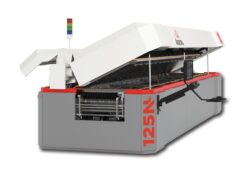Welcome to the CUI Product Spotlight on Electret Condenser Microphones (ECM). Learn about CUI’s electret condenser microphone product line, including a description of electret condenser microphone technology, common features, and working principles. Key specifications including polarity patterns and possible applications will also be highlighted.
Objectives
- Outline electret condenser microphone technology and working principles
- Define common specifications
- Introduce microphone polarity patterns
- Highlight various models in CUI’s microphone line
- Cover typical applications
Electret Condenser Microphone Usage
 Electret condenser microphones are used to convert sound into an electrical signal and are used in a wide variety of consumer electronic products, including mobile phones, GPS devices, and speech recognition equipment.
Electret condenser microphones are used to convert sound into an electrical signal and are used in a wide variety of consumer electronic products, including mobile phones, GPS devices, and speech recognition equipment.
Typical Usage
- Convert sound into an electrical signal
Commonly Used In
- Telephones
- GPS
- Hearing Aids
- FRS Radios
- Speech Recognition
- VoIP
Electret Condenser Microphone Technology
 CUI’s microphone line is composed of electret condenser microphones which are also called capacitor microphones. What makes electret condenser microphones different than other condenser microphones is the use of an electret. An electret is a ferroelectric material that has been permanently electrically charged or polarized. Due to the high resistance and chemical stability of the material, the electrical charge will not decay for hundreds of years. The name comes from “electrostatic and magnet”; a static charge is embedded in an electret by alignment of the static charges in the material, much the way a magnet is made by aligning the magnetic domains in a piece of iron. This specific characteristic is a benefit to designers because an electret microphone eliminates the need for a polarizing voltage to operate the microphone.
CUI’s microphone line is composed of electret condenser microphones which are also called capacitor microphones. What makes electret condenser microphones different than other condenser microphones is the use of an electret. An electret is a ferroelectric material that has been permanently electrically charged or polarized. Due to the high resistance and chemical stability of the material, the electrical charge will not decay for hundreds of years. The name comes from “electrostatic and magnet”; a static charge is embedded in an electret by alignment of the static charges in the material, much the way a magnet is made by aligning the magnetic domains in a piece of iron. This specific characteristic is a benefit to designers because an electret microphone eliminates the need for a polarizing voltage to operate the microphone.
Electret Condenser Microphone Structure
 The typical structure of an electret condenser microphone is composed of a non-woven cloth, a case, a polar ring, a diaphragm, a spacer, a back plate, a base, a copper ring, and a printed circuit board (PCB). The electret material is applied to the diaphragm and shown as the polar ring.
The typical structure of an electret condenser microphone is composed of a non-woven cloth, a case, a polar ring, a diaphragm, a spacer, a back plate, a base, a copper ring, and a printed circuit board (PCB). The electret material is applied to the diaphragm and shown as the polar ring.
Assembled Electret Condenser Microphone Structure
 The structure of a typical electret condenser microphone in an assembled state is highlighted here.
The structure of a typical electret condenser microphone in an assembled state is highlighted here.
Working Principle of ECMs
 The working principle of an electret condenser microphone is that the diaphragm acts as one plate of a capacitor. Vibrations produce changes in the distance between the diaphragm and the back plate. The voltage maintained across the diaphragm and the back plate changes with the vibrations in the air, according to the capacitance equation (C = Q / V), where Q = charge in coulombs, C = capacitance in farads and V = potential difference in volts. This change in voltage is amplified by the FET and the audio signal appears at the output, after a dc-blocking capacitor.
The working principle of an electret condenser microphone is that the diaphragm acts as one plate of a capacitor. Vibrations produce changes in the distance between the diaphragm and the back plate. The voltage maintained across the diaphragm and the back plate changes with the vibrations in the air, according to the capacitance equation (C = Q / V), where Q = charge in coulombs, C = capacitance in farads and V = potential difference in volts. This change in voltage is amplified by the FET and the audio signal appears at the output, after a dc-blocking capacitor.
Key Microphone Specifications
Directivity
- A microphone’s directionality or polar pattern indicates how sensitive it is to sounds arriving at different angles about its central axis.
Sensitivity Reduction
- The amount of gain that a microphone will lose if the voltage powering the microphone is decreased.
Sensitivity
- A microphone’s sensitivity rating serves to tell you the microphone’s gain, or level of sound a microphone records at. For a given signal, one microphone may record the signal at a low level, resulting in a low sensitivity rating, while another microphone may record the same signal at a loud level, resulting in a high sensitivity rating.
Signal to Noise Ratio
- A ratio measuring the level of a desired signal (such as speech, music, etc.) that a microphone records compared to the level of noise that it picks up from the background.
Microphone Directionality or Polar Patterns
 CUI’s microphones are available in omnidirectional, unidirectional, and noise canceling directivity or polar patterns, which will now each be explained in greater detail.
CUI’s microphones are available in omnidirectional, unidirectional, and noise canceling directivity or polar patterns, which will now each be explained in greater detail.
Omnidirectional Frequency Response


Omnidirectional microphones are designed to receive vibrations from virtually any direction. The diagram on this slide illustrates the pattern of how the microphone receives sound. The microphone faces upward (toward the viewer) and sound intensity for a particular frequency is plotted for angles radially from 0° to 360°. Because these microphones can pick up sound from any direction, they are often used to record a group of vocalists, or for meetings such as conference calls. However, omnidirectional microphones do have some drawbacks. As the microphone cannot discriminate between wanted and unwanted sounds, ambient noise from the environment can be picked up and amplified.
Unidirectional Frequency Response


Unidirectional microphones are sensitive to sounds primarily from one direction and eliminate unwanted background noises, such as chatter, keyboard, or paper sounds. The diagram on this slide illustrates the pattern of how the microphone receives sound. The microphone faces upward and the sound intensity for a particular frequency range is plotted for angles radially from 0° to 360°. Microphones with this type of pattern are commonly used as vocal or speech microphones, since they are good at rejecting sounds from directions other than the desired location.
Noise Cancelling Frequency Response


A noise canceling microphone is designed to filter out ambient noise from a desired sound or direction. These are particularly useful in noisy environments. The diagram on this slide illustrates the pattern of how the microphone receives sound. The microphone faces upward and sound intensity for a particular frequency is plotted for angles radially from 0° to 360°. All noise canceling microphones have at least two ports through which sound enters. The front port is normally oriented toward the desired sound and another port is oriented at a sound that is more distant. Sound that is much closer to the front port than to the rear will make more of a pressure gradient between the front and back of the diaphragm, causing it to move more. The microphone’s proximity effect is adjusted so that flat frequency response is achieved for sound sources very close to the front of the microphone. Sounds arriving from other angles are subject to steep midrange and bass roll-off. Noise canceling microphones are found in call center, helicopter, and race car driver headsets.
Electret Condenser Microphone Mounting Types
 CUI’s microphones are available in various mounting configurations depending on the application requirement, including PCB pin, wire lead, and terminal types.
CUI’s microphones are available in various mounting configurations depending on the application requirement, including PCB pin, wire lead, and terminal types.
Design for ECM Mounting
 When mounting an electret condenser microphone, the microphone should be mechanically isolated from the product enclosure, so sound and vibrations are not transferred from the enclosure to the microphone and to ensure the microphone only receives sounds from the front holes of the enclosure. The thickness of the enclosure in front of the microphone should be less than 1 mm, while the holes in front of the microphone should have a diameter greater than 1.3 mm for a single hole or greater than 0.8 mm for multiple holes. Elongated holes should have a width greater than 0.8 mm.
When mounting an electret condenser microphone, the microphone should be mechanically isolated from the product enclosure, so sound and vibrations are not transferred from the enclosure to the microphone and to ensure the microphone only receives sounds from the front holes of the enclosure. The thickness of the enclosure in front of the microphone should be less than 1 mm, while the holes in front of the microphone should have a diameter greater than 1.3 mm for a single hole or greater than 0.8 mm for multiple holes. Elongated holes should have a width greater than 0.8 mm.
 For low vibration applications the microphone can be mounted by friction fit or glued into a sleeve, while for high vibration applications the mounting sleeve should be extended, so glue can also be applied to the back of the microphone and the sleeve.
For low vibration applications the microphone can be mounted by friction fit or glued into a sleeve, while for high vibration applications the mounting sleeve should be extended, so glue can also be applied to the back of the microphone and the sleeve.










